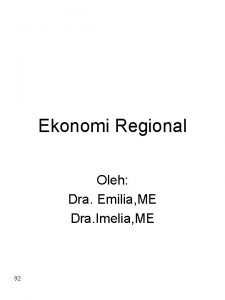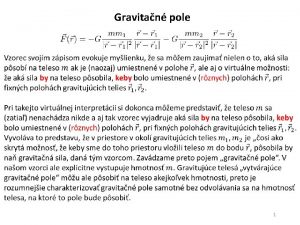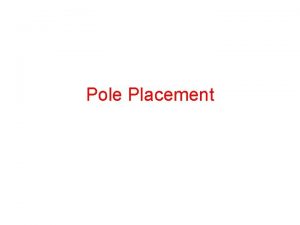Growth Pole Theory LECTURE9 Growth Pole Theory the












- Slides: 12

Growth Pole Theory LECTURE-9

Growth Pole Theory; the Origin Growth Pole/Center Theory Central Place Theory Industrial Location Theories

Growth Pole Theory; the definition Perroux (1950) • The basic fact of spatial and industrial development is that ‘growth does not appear everywhere and all at once; it appears in points or development poles, with variable intensities; it spreads along diverse channels and with varying terminal effects to the whole economy’. Boudeville (1966) • A regional growth pole is a ‘ set of expanding industries located in an urban area and inducing further development of economic activity throughout its zone of influence’.

Other cumulative growth models Growth pole: Perroux (1950), Myrdal (1957), and Hirschman (1958) The theory says that if an industry is subject to significant internal economies of scale, the firms grow quickly and will gain a competitive advantage over rivals and growth will be cumulative. Localization economies: Localization economies result from the geographical concentration of plants in the same industry at the locality. Located close to each other, the firms with input-output ties can enjoy benefits, such as the low costs of transportation, quick exchange of information, ideas and knowledge, and the spillover effects of cross-fertilization. Clustering allows individual plants to specialize more than they would if firms are widely apart. The increase in specialization will increase the productivity and competitiveness of the industry…. Agglomeration Economies.

Is Growth Pole a Theory? Over the years, the application of Growth Pole/Center theory has not progressed further than theoretical underpinnings. This can be clearly seen in the vast confusion of terminology with not only growth poles and growth points, but also growth centers, development poles, development axes, growth zones and growth areas… Some have characterized it as ‘Terminological Anarchy’. Darwent (1969) describe that ‘it has become associated with an enormous variety of indistinct and ill-defined concepts and notions’. Hansen (1967) believes that ‘the whole of growth pole literature badly needs of a thorough semantic reworking’.

Growth Pole Theory; Basic Concepts From various writings on growth poles (pole de croissance) and growth centers, following basic economic concepts and their geographical development can be identified: 1. The concept of leading industries & propulsive firms (industrie motrice) 2. The concept of polarization effects & agglomeration economics 3. Spread effects or trickling down effects

1. Leading Industries & Propulsive Firms 1. 2. A leading industry has the following characteristics: a. it is relatively new and dynamic industry with an advanced level of technology injecting an atmosphere of ‘growth mindedness’ into a region; b. it has a high income elasticity of demand for its products which are usually sold to national markets; c. it has a strong inter-industry linkages with other sectors (these linkages may either be ‘forward’ or ‘backward’. Fore instance, the following were identified as leading manufacturing industries in Britain in 1970’s: • Chemicals (SIC V) • Electrical Engineering (SIC IX) • Metal goods (SIC XII) • Furniture (SIC XVII) and • Other manufacturing industries (SIC XIX) Similarly a propulsive firm has the following characteristics: a. it is relatively large; b. it generates significant growth impulses into its environment; c. It has a high ability to innovate; d. It belongs to a fast growing industry. In Pakistan some of the leading industries includes:

2. Polarization Effects & Agglomeration Economies Once established, the propulsive firm or complex of propulsive firms within leading industry tend to grow rapidly reaping the advantages of agglomeration economies and effecting the polarization of other economic activities around the original location. Four types of agglomeration economies can be identified: 1. Economies internal to the firm 2. Economies external to the firm but internal to the industry 3. Economies external to the industry but internal to the urban area 4. Economies external to the urban area but internal to global market Some examples of polarization due to agglomeration economies includes: Textile industry in North East Lancashire Vehicles and aerospace industry in the town of Coventry Sports industry in Sialkot and Textile in Faisalabad Metal and fan industry in Gujranwala and Gujrat corridor. Scale economies Localization economies Urbanization economies Globalization economies Also think about diseconomies of scales? ? ?

Diseconomies of Scales & Optimum City Size Bettencourt sees the planner’s job is to try to steer cities toward that optimal point (G*) on the shown graph. Beyond that point, the number of social interactions in a city can still grow, but the cost of them rises faster than the benefit. Some of the notable diseconomies includes: Rising public services costs Rising factor prices such as wages and site rents Rising congestion costs Rising environmental costs Longer trips and high travelling costs "The Origins of Scaling in Cities, " by L. M. A. Bettencourt in Science

3. Spread Effects This is the most difficult aspect of theory to examine as there is very little empirical evidence that diffusion takes place outwards from the growth pole Myrdal and Hirschman talks about ‘spread’ and ‘trickling down’ effects of growth poles in contrast with the ‘backwash’ and ‘polarization’ effects, but there have been considerable doubts over relative strengths of spread in comparison with backwash. Fore example, Vida Nichol measures the spread effects from the growth pole of Atlanta into the relatively depressed state of Georgia, USA She observed a positive change in the median income distribution over a period of 10 years (1950 -60) included a region wide increase associated with a general shift in employment, but also a residual element which was highest in the suburban ring around Atlanta and in other large towns in the area. The location of spread effects with the propulsive influence of growth pole felt first in other major towns in the region and in the rural area immediately surrounding the growth pole, and then spreading to other interstitial rural areas.

Application typology of Growth Pole Theory 1. 2. 3. 4. Policy/Function Policy of Development Policy of Relief Policy of Development and Relief Level Primary Industry Secondary Industry Tertiary Industry Strategy Active Passive Form Growth Pole Policy Growth Center Policy

r row (Pa ing rr, 197 urba nc 3) ent e Ag Ag ind rowi sur ucin ng ur rou g gr ban o n (Ni cho ding wth i cente n h r les , 19 inter its lan 69) d As of patia loc relate l agg cen ated d ind lome the ter, in an ustr ratio gro ir ex which urba ies, n hin wth pans thro n io in te u (Bo rland surron ind gh ud un uce evi din lle, g 196 6) As of patia wh relate l agg gro ich c d ind lome ind wing ontai ustr ratio ns ie n u p (La stry ropu a s lsiv use e n, 1 974 ) As of patia re l (Mc lated agglo in m Cro ne, dustr eratio ies 196 n 9) Reinterpretations of Growth Pole Theory (Perroux, 1950)























